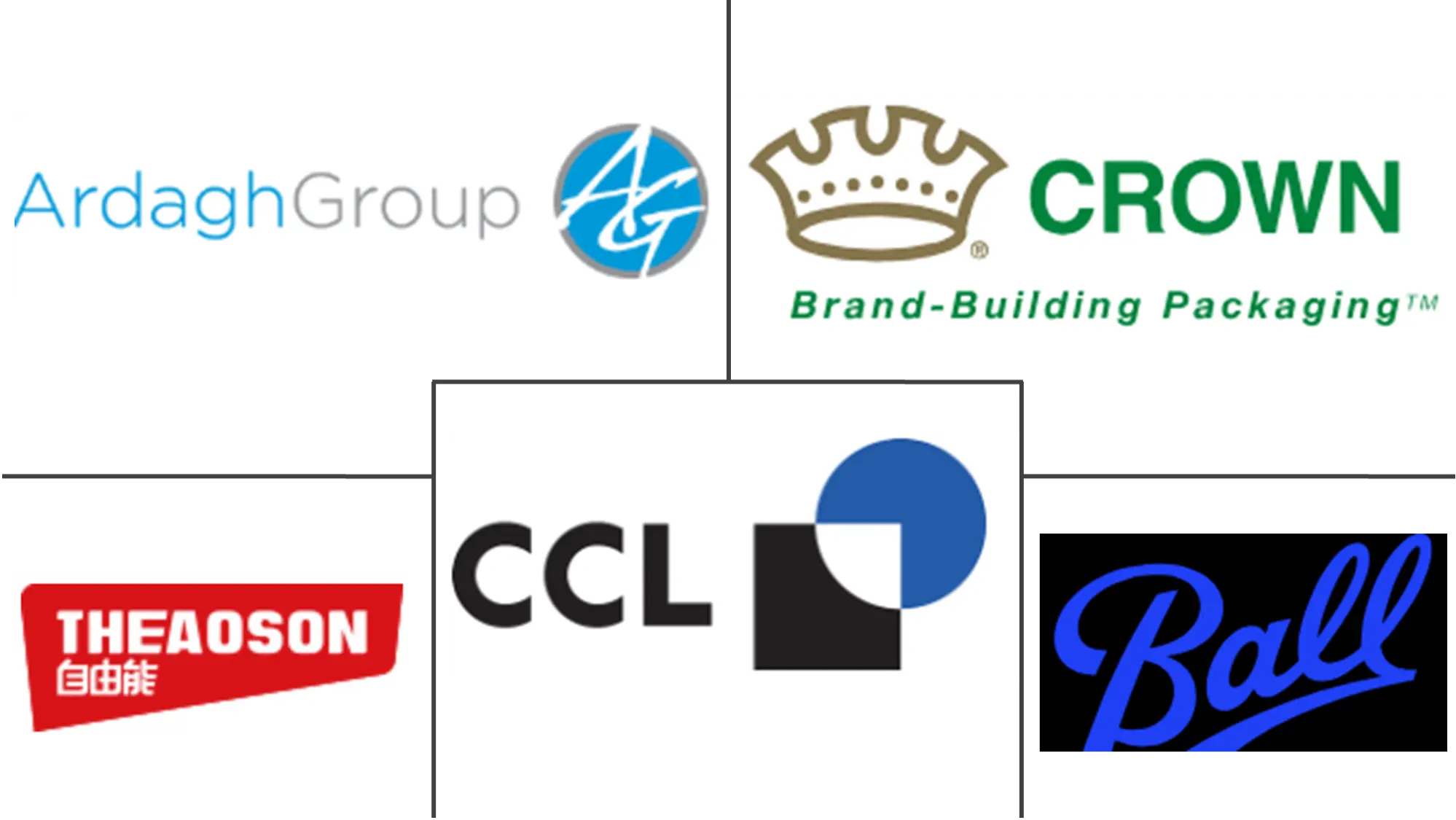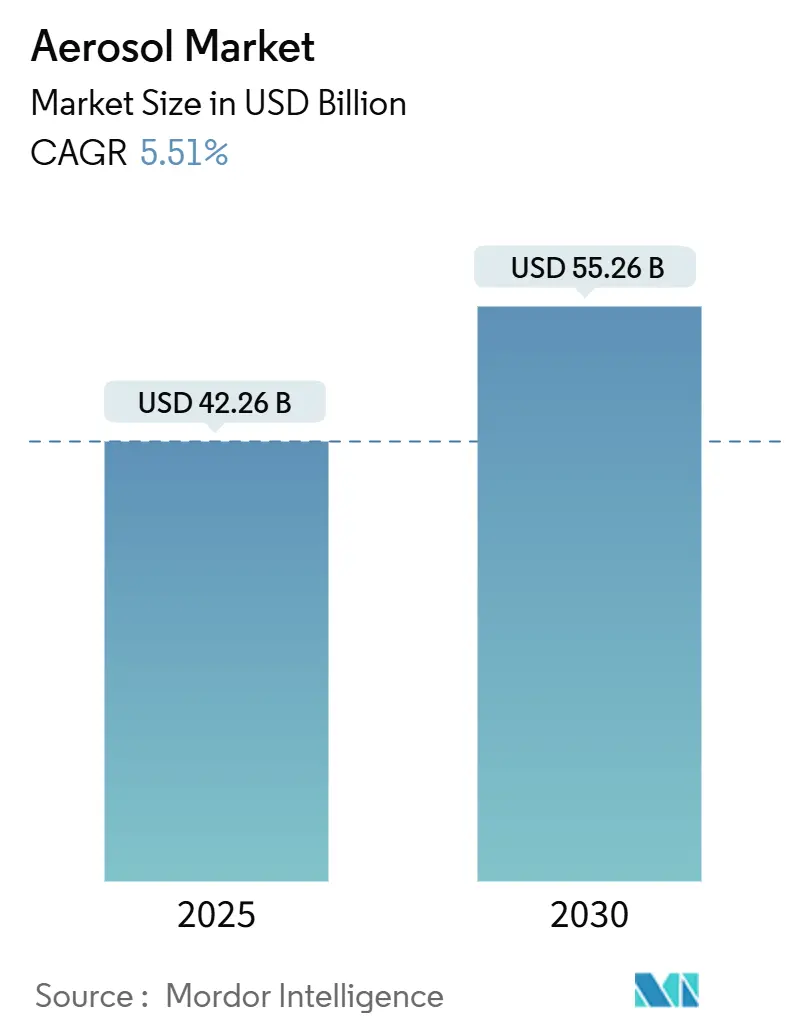
Aerosol Market Analysis by Mordor Intelligence
The Aerosol Market size is estimated at USD 42.26 billion in 2025, and is expected to reach USD 55.26 billion by 2030, at a CAGR of 5.51% during the forecast period (2025-2030). Steady gains stem from consumer preference for convenient, pressurized dispensing across personal care, medical, and industrial uses. Early compliance with evolving F-gas regulations, particularly in Europe, is accelerating the transition from hydrofluorocarbons (HFCs) to hydrofluoroolefins (HFOs). Europe’s regulatory leadership is shaping global formulations, while e-commerce and direct-to-consumer channels are extending product reach and reinforcing demand for lightweight, recyclable cans. Ongoing aluminum price fluctuations and the pursuit of lower-carbon packaging intensify competition among material suppliers, yet they also create opportunities for product differentiation through recycled content and universal waste program coverage.
Key Report Takeaways
- By propellant, hydrofluorocarbons retained a 41.3% share of the aerosol market in 2024; hydrofluoro olefins are expanding at a 6.9% CAGR through 2030.
- By can type, aluminum held a 46.2% share of the aerosol market size in 2024, whereas plastic containers are forecast to post a 6.1% CAGR to 2030.
- By application, personal care led with 34.5% aerosol market share in 2024, while medical aerosols are advancing at a 6.5% CAGR to 2030.
- By geography, Europe commanded 32.4% revenue share of the aerosol market in 2024 and is growing at a 6.58% CAGR through 2030.
Global Aerosol Market Trends and Insights
Drivers Impact Analysis
| Drivers | (~) % Impact on CAGR Forecast | Geographic Relevance | Impact Timeline |
|---|---|---|---|
| Rising demand for personal-care and hygiene aerosols | +1.2% | Global, with premium growth in Europe and North America | Medium term (2-4 years) |
| Expansion of paints-and-coatings spray applications | +0.8% | APAC core, spill-over to industrial regions | Long term (≥ 4 years) |
| Convenience-driven portable packaging across sectors | +1.0% | Global, led by e-commerce penetration | Short term (≤ 2 years) |
| Regulatory shift to low-GWP propellants spurring re-tooling | +0.9% | Europe and North America, expanding to APAC | Medium term (2-4 years) |
| E-commerce growth of food/dairy dispensing aerosols | +0.6% | North America and Europe, emerging in APAC | Short term (≤ 2 years) |
| Source: Mordor Intelligence | |||
Rising Demand for Personal-Care and Hygiene Aerosols
Premiumization in beauty and grooming drives the wider use of pressurized formats, which offer precise dosing, hygienic delivery, and longer product shelf life. India’s skincare segment is experiencing growth, driven by the popularity of SPF-infused sprays and hybrid moisturizers. Global brand owners are bolstering innovation pipelines around refillable metal cans and airless systems to address VOC caps while retaining convenience credentials. Patent filings for low-VOC dry shampoo underscore how leading firms prioritize both emissions compliance and scalp-friendly formulations. European makers strengthen brand equity by spotlighting aerosols’ ability to shield contents from oxidation and contamination[1]European Aerosol Federation, “Uses & Benefits,” aerosol.org. Collective effect: premium price elasticity offsets propellant reformulation costs and sustains aerosol market growth.
Expansion of Paints-and-Coatings Spray Applications
Industrial users adopt electrostatic spray technology to curb overspray by up to 30%, enhancing material efficiency in large-area coatings. Southeast Asian infrastructure booms—Indonesia’s paint demand topped 1 million tons in 2024—support higher volumes for protective aerosols used on steel, concrete, and composite surfaces. Auto refinish segments favor touch-up aerosols for color-matching versatility. Water-based formulas compliant with stricter VOC ceilings still require propellants that maintain atomization, thereby driving the uptake of dimethyl ether and other alternatives. Agricultural drones now rely on aerosol-compatible formulations to spread pesticides evenly across narrow rows, opening new revenue streams for propellant suppliers. Compliance with ISO 14001 standards guides the procurement of eco-optimized solvents and additives.
Convenience-Driven Portable Packaging Across Sectors
One-handed operation and metered spray volumes reduce labor time for cleaning staff and disinfectant waste. Demand for antimicrobial coatings parallels growth in UV-C surface disinfection protocols, encouraging specialty aerosol lines for healthcare, hospitality, and transit hubs. Direct-to-consumer logistics allow niche brands to sell concentrated or fragrance-free variants without shelf-space limitations. In the U.S., nearly 4 billion aerosol containers are sold each year, of which many enter the waste stream[2]Household & Commercial Products Association, “Aerosol Recycling Initiative,” thehcpa.org . In 2024, 79.1% were emptied to below 3% residue, confirming efficient consumer use patterns. Food-service operators prize aerosol whipped toppings for their portion control and stability at warmer temperatures, facilitating cost-effective shipping via online grocery platforms. Portability also enhances the productivity of field technicians in the electrical and HVAC sectors, where on-site lubricant sprays minimize downtime.
Regulatory Shift to Low-GWP Propellants Spurring Re-tooling
The phasedown schedule of high-GWP gases in Europe and multiple U.S. states demands wholesale changeover to HFOs and bio-based dimethyl ether. Nouryon’s bio-DME offers a drop-in route that leverages existing LPG storage, curbing capital outlays for filling lines. The Technology and Environmental Assessment Panel notes that 36 U.S. states, plus Washington, D.C., include aerosols in their universal waste programs as of February 2024, thereby curtailing disposal complexity and associated fees. Medical device approvals for new propellants require clinical equivalency tests, rewarding firms that finalize validation early. Capacity expansions by Mitsubishi Gas Chemical ensure a stable supply ahead of peak demand, minimizing transition bottlenecks. Producers with first-mover compliance gain pricing power worldwide.
Restraints Impact Analysis
| Restraints | (~) % Impact on CAGR Forecast | Geographic Relevance | Impact Timeline |
|---|---|---|---|
| Stringent VOC/F-gas regulations | -0.7% | Europe and North America, expanding globally | Medium term (2-4 years) |
| Flammability and safety liabilities | -0.4% | Global, with varying regulatory thresholds | Long term (≥ 4 years) |
| Energy-intensive aluminum supply tightening can margins | -0.6% | Global, concentrated in China production | Short term (≤ 2 years) |
| Source: Mordor Intelligence | |||
Stringent VOC/F-gas Regulations
Divergent limits on volatile organic compounds oblige region-specific formulations and double certification costs. Consumer deodorants tested in Korea emitted 13.89 ppm of total VOC at a 1-meter distance, with certain benzene levels exceeding proposed ACGIH limits, indicating compliance hurdles for fragrance-heavy aerosols. The European Union’s F-gas quota auction elevates the price of high-GWP blends, compelling even small brands to adopt cleaner chemistries. Air Label Score criteria force proof of low indoor emissions, extending time-to-market for new SKUs. Inventory tied to legacy propellants risks write-downs if phaseout dates accelerate. Global distributors must navigate a patchwork of rules, which raises logistics overhead for multi-country rollouts.
Energy-Intensive Aluminum Supply Tightening Can Margins
Primary smelters rely heavily on coal-based power, making aluminum vulnerable to carbon taxation schemes. China supplies approximately 60% of the global ingot market, so regional disruptions or export caps can cause sudden shifts in global spot prices. Smelters account for most of the aerosol can emissions footprint; therefore, brand owners are increasingly mandating recycled content targets to hedge against carbon cost pass-throughs. Some European extended producer responsibility laws require fee payments based on packaging weight, incentivizing down-gauging or the adoption of novel alloys. Rapid demand from automotive body-sheet producers competes for the same feedstock, further straining availability. Can makers invest in closed-loop recovery programs to stabilize billet supply and showcase circularity credentials.
Segment Analysis
By Propellant Type: HFO Adoption Accelerates While HFCs Remain Predominant
Hydrofluorocarbons held a 41.3% market share in the aerosol sector in 2024, underpinned by well-established supply chains and broad formulation compatibility. Yet tightening phase-down quotas are steering customers toward hydrofluoro-olefins, which are projected to post a 6.9% CAGR through 2030. Dimethyl ether, produced from bio-methanol, is drawing attention for its negative carbon intensity profile and WHO endorsement for medical uses. Nitrous oxide and carbon dioxide still dominate edible and technical segments where non-flammability is mandatory. Early movers completing medical device validations with HFO propellants enjoy premium pricing and longer contract tenures.
Adoption rates vary by region, with Europe leading due to earlier F-gas restrictions, while North America accelerates the transition through state-level mandates. In the Asia-Pacific region, larger multinational personal care players follow global formulation standards, whereas local brands gradually phase in alternatives. Suppliers capable of offering bundled propellant plus sustainability certification packages capture loyal demand. Investments in HFO capacity mitigate long-term supply risk and stabilize cost structures for downstream fillers.
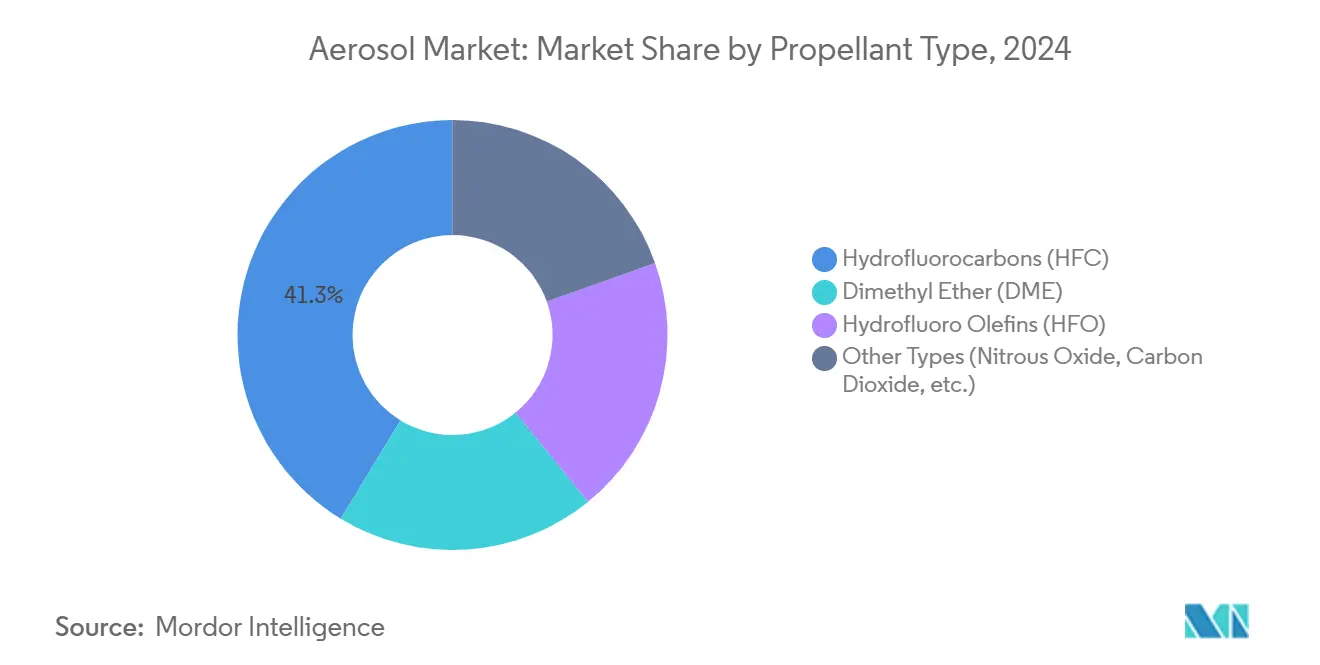
Note: Segment shares of all individual segments available upon report purchase
By Can Type: Aluminum Leadership Faces Plastic Resurgence
Aluminum accounted for a 46.2% share of the aerosol market size in 2024, recognized for its barrier integrity and recyclability. Steel serves heavy-duty applications where burst pressures exceed 18 bar, and its global recycling rate of above 70% aligns with circular economy narratives. Plastic containers, however, are forecast to deliver a 6.1% CAGR, favored for cost efficiency and design flexibility, such as asymmetric shapes and transparent windows. Re:gen low-carbon cans from Ball Corporation use high recycled content and cut cradle-to-gate greenhouse gases by 50%, securing shelf premium among eco-conscious brands. Guangdong Sihai’s 260 million-unit capacity illustrates Asian scaling benefits that compress per-unit aluminum cost.
Material selection is increasingly influenced by lifecycle analyses requested by retailers. Brand owners hedge raw-material volatility by dual-sourcing aluminum and post-consumer-recycled PET versions of flagship SKUs. Composite and hybrid can technologies seek to merge metal aerosol performance with polymer cost savings, aiming to balance sustainability and functionality. Machinery suppliers invest in quick-change tooling systems that enable the switching of material formats without lengthy downtime, thereby improving operational agility.
By Application: Medical Growth Outpaces Personal-Care Dominance
Personal care retained 34.5% aerosol market share in 2024 through entrenched grooming habits and added-value claims such as micro-mist finishing. Meanwhile, medical aerosols are slated to register a 6.5% CAGR through 2030, propelled by demand for rescue inhalers and disinfectant sprays in healthcare settings. The aerosol market size for medical applications is growing, as the adoption of low-GWP propellants aligns with hospital sustainability goals. Automotive touch-up paints benefit from rapid-drying propane-based blends, offering time savings in service centers. Food products, including whipped toppings and cooking sprays, gain traction due to portion control and the rise of home baking. Agricultural formulations adopt drone-spray compatible aerosols to minimize chemical drift and improve field efficiency.
Industrial users rely on aerosol degreasers and lubricants to cut maintenance downtime. Household segments face competition from trigger sprayers but retain niche leadership in disinfectants requiring hermetic storage. Market players are innovating with 360-degree valve technology and active-pack systems that dispense viscous contents, thereby widening the application boundaries.

Note: Segment shares of all individual segments available upon report purchase
Geography Analysis
Europe accounted for 32.4% of the global aerosol market in 2024 and is forecast to grow at a 6.58% CAGR through 2030. Stringent F-gas legislation and robust recycling infrastructure are spurring the rapid uptake of HFO propellants and low-carbon metal cans. Germany, France, and the United Kingdom lead research and development investments focused on premium personal-care and industrial formulations. Retailers promote products bearing eco-labels that highlight the aerosols' benefits of contamination-free delivery. Earlier compliance timetables enable European fillers to license technology abroad and capture a share in emerging markets.
Asia-Pacific shows the fastest incremental volume gains, driven by infrastructure growth and rising discretionary spending. China’s aluminum dominance secures supply-chain cost advantages, although coal-intensive smelting raises concerns about its carbon footprint, which stimulates demand for recycled aluminum. India’s expanding skincare market stimulates local filling capacity, while Indonesia’s one-million-ton paint sector buoys industrial sprays. Japan and South Korea emphasize precision valves and safety certifications, exporting high-performance components across the region.
North America remains a mature but sizable contributor, buoyed by almost 4 billion aerosol cans sold annually. Universal waste rules adopted by 36 states lower disposal barriers and promote curbside collection schemes. E-commerce accelerates adoption of portable food and cleaning aerosols that bypass cold chains. Mexico emerges as a strategic export platform after Beiersdorf’s EUR 350 million Silao expansion, feeding regional personal-care demand. Canada’s focus on low-VOC standards parallels U.S. regulations, streamlining multi-country product launches.
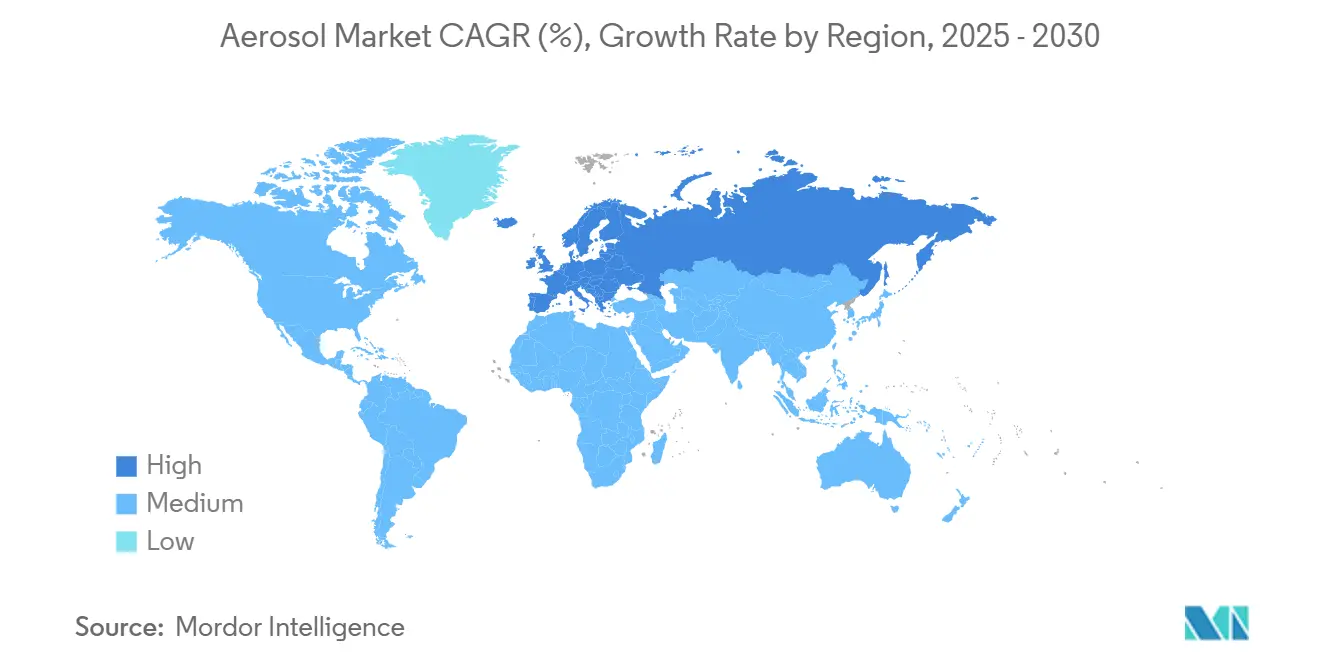
Competitive Landscape
The Aerosol Market is moderately fragmented. Regulatory foresight defines competitive edge. Firms that validated HFO propellants early now command price premiums and longer supplier lock-ins. Small and mid-size fillers partner with contract packers to offer turnkey, low-GWP solutions, circumventing heavy capital expenditures. Ongoing raw material volatility incentivizes multinationals to hedge by regional sourcing of aluminum billets and aerosol valves. Digital supply-chain platforms enhance traceability, a growing procurement criterion for retailers prioritizing ESG disclosures. New entrants pursue niche segments such as drone-spray agrochemicals or single-origin culinary foams where performance requirements outweigh incumbents’ scale advantages. Established players counter through strategic alliances.
Aerosol Industry Leaders
-
Ball Corporation
-
Crown
-
Guangdong Theaoson Technology Co. Ltd.
-
Ardagh Group S.A,
-
CCL Container
- *Disclaimer: Major Players sorted in no particular order
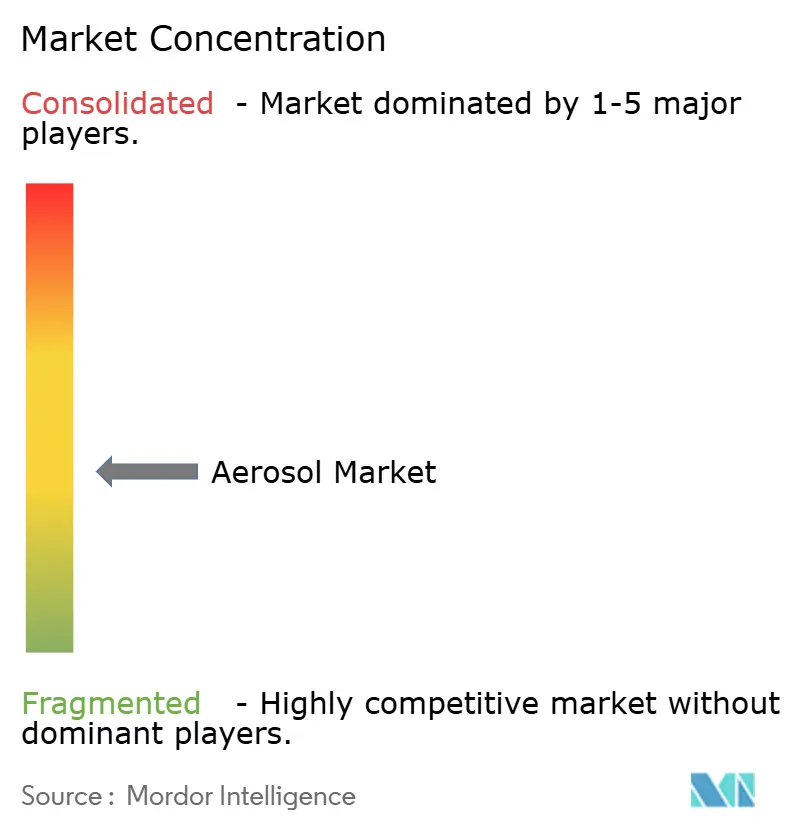
Recent Industry Developments
- September 2025: Ball Corporation partnered with Brazilian brands Soffie and Aeroflex to launch ASI-certified aluminum aerosol cans, establishing a new sustainability benchmark.
- August 2025: Beiersdorf has committed EUR 350 million to expand its Silao, Mexico site, adding advanced aerosol filling lines that align with the company’s 2045 carbon-neutral target.
Global Aerosol Market Report Scope
Aerosols are extremely tiny solid particles or liquid droplets suspended in the air or other gases. They consist of solid particles that can be placed in the atmosphere by large dust storms, volcanic eruptions, or soot particles from large fires.
The market is segmented by propellant type, can type, application, and geography. By propellant type, the market is segmented into dimethyl ether (DME), hydrofluorocarbons (HFC), hydrofluoro olefins (HFO), and other types (nitrous oxide and carbon dioxide, etc.). By can type, the market is segmented into steel, aluminum, plastic, and other can types (glass and tin). By application, the market is segmented into automotive, personal care, food products, agriculture, household products, industrial and technical, medical, paints and coatings, and other applications (cleaning products, sprays, etc.). The report also covers the market size and forecasts for the aerosol market in 27 countries across major regions. For each segment, market sizing and forecasts were made on the basis of value (USD).
| Dimethyl Ether (DME) |
| Hydrofluorocarbons (HFC) |
| Hydrofluoro Olefins (HFO) |
| Other Types (Nitrous Oxide, Carbon Dioxide, etc.) |
| Steel |
| Aluminum |
| Plastic |
| Other Can Types (Glass and Tin) |
| Automotive |
| Personal Care |
| Food Products |
| Agriculture |
| Household Products |
| Industrial and Technical |
| Medical |
| Paints and Coatings |
| Other Applications (Cleaning Products, Sprays, etc.) |
| Asia-Pacific | China |
| India | |
| Japan | |
| South Korea | |
| ASEAN Countries | |
| Rest of Asia-Pacific | |
| North America | United States |
| Canada | |
| Mexico | |
| Europe | Germany |
| United Kingdom | |
| France | |
| Italy | |
| Spain | |
| Russia | |
| Rest of Europe | |
| South America | Brazil |
| Argentina | |
| Rest of South America | |
| Middle-East and Africa | Saudi Arabia |
| United Arab Emirates | |
| South Africa | |
| Rest of Middle-East and Africa |
| By Propellant Type | Dimethyl Ether (DME) | |
| Hydrofluorocarbons (HFC) | ||
| Hydrofluoro Olefins (HFO) | ||
| Other Types (Nitrous Oxide, Carbon Dioxide, etc.) | ||
| By Can Type | Steel | |
| Aluminum | ||
| Plastic | ||
| Other Can Types (Glass and Tin) | ||
| By Application | Automotive | |
| Personal Care | ||
| Food Products | ||
| Agriculture | ||
| Household Products | ||
| Industrial and Technical | ||
| Medical | ||
| Paints and Coatings | ||
| Other Applications (Cleaning Products, Sprays, etc.) | ||
| By Geography | Asia-Pacific | China |
| India | ||
| Japan | ||
| South Korea | ||
| ASEAN Countries | ||
| Rest of Asia-Pacific | ||
| North America | United States | |
| Canada | ||
| Mexico | ||
| Europe | Germany | |
| United Kingdom | ||
| France | ||
| Italy | ||
| Spain | ||
| Russia | ||
| Rest of Europe | ||
| South America | Brazil | |
| Argentina | ||
| Rest of South America | ||
| Middle-East and Africa | Saudi Arabia | |
| United Arab Emirates | ||
| South Africa | ||
| Rest of Middle-East and Africa | ||
Key Questions Answered in the Report
How large is the aerosol market in 2025?
The aerosol market size is USD 42.26 billion in 2025.
What is the projected growth rate for aerosols through 2030?
The market is forecast to grow at a 5.51% CAGR, reaching USD 55.26 billion by 2030.
Which region leads aerosol sales?
Europe leads with a 32.4% share in 2024 and the fastest 6.58% CAGR to 2030.
Which propellant is gaining fastest adoption?
Hydrofluoro Olefins show a 6.9% CAGR as regulations phase down HFCs.
Why are aluminum cans still dominant?
Aluminum offers strong barrier protection, high recyclability, and benefits in consumer perception, despite volatility in raw material prices.
What drives growth in medical aerosols?
Advances in respiratory devices and hygiene protocols push medical aerosols to a 6.5% CAGR through 2030.
Page last updated on:
